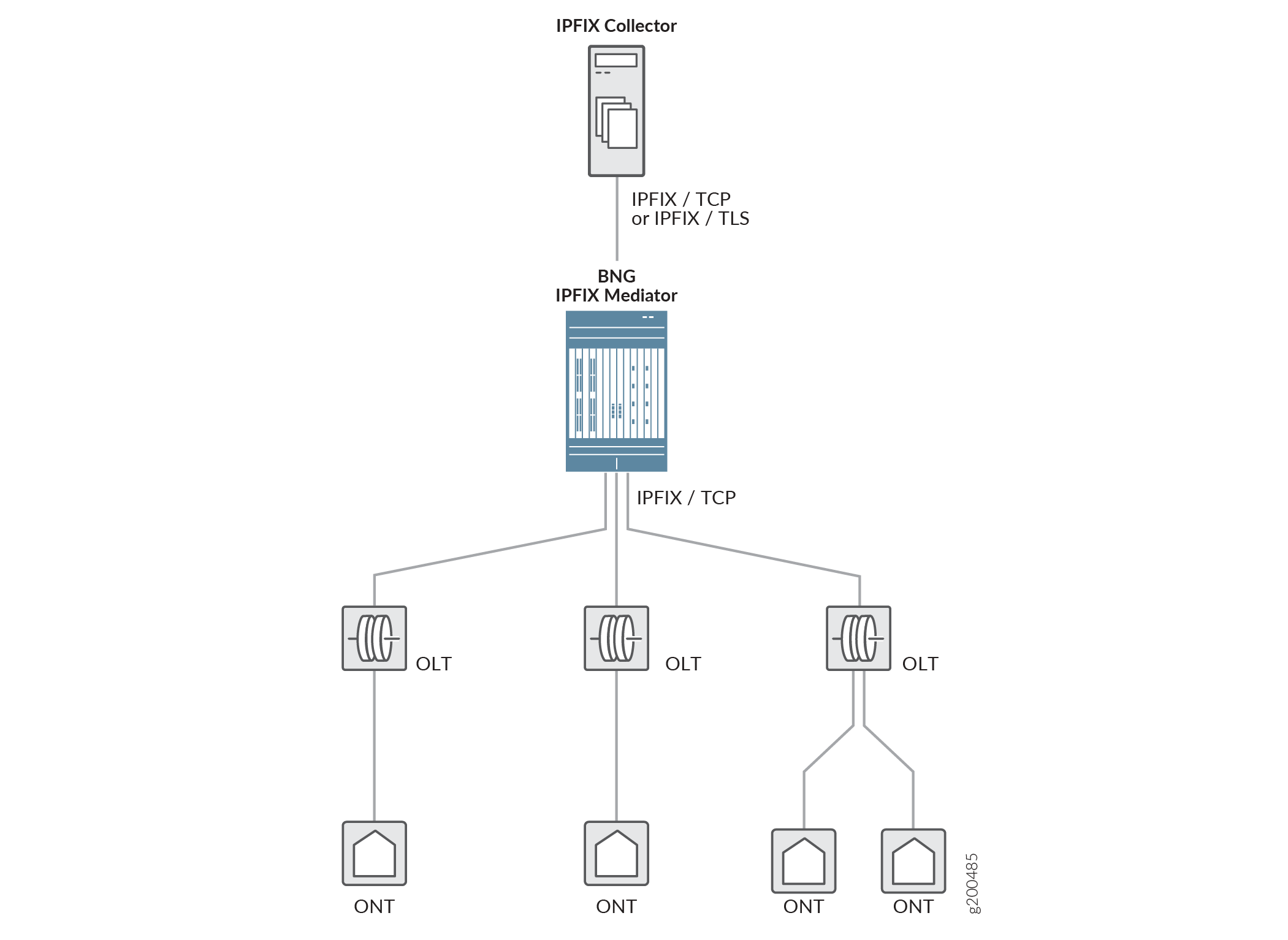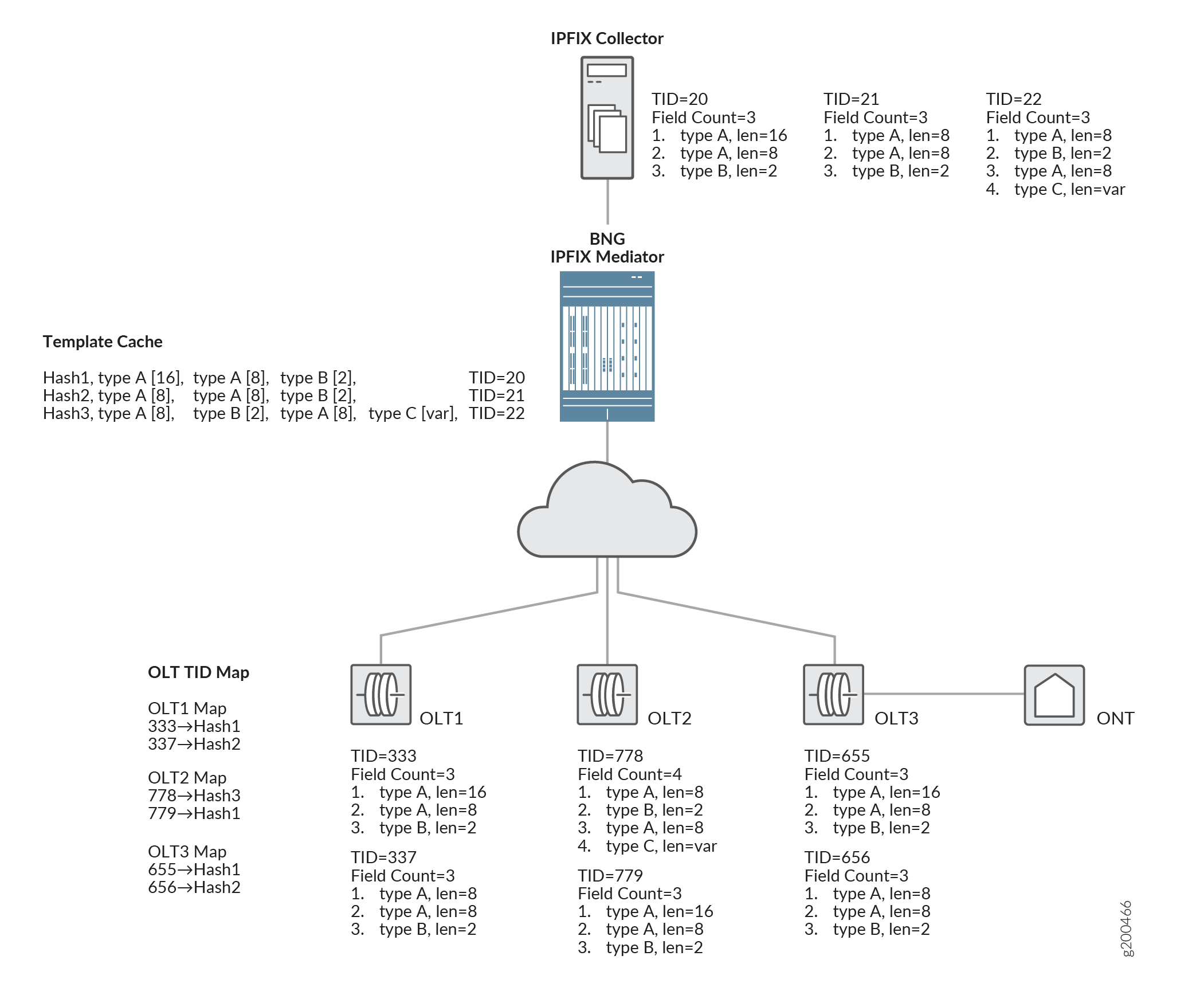IPFIX Mediation on the BNG
Traffic flow is a way of conceptualizing how IP data traffic passes through the various components of your network. A flow consists of a set of IP packets that pass an observation point in the network during a specific time interval. The set is defined by common properties:
One or more packet, transport, or application header fields
One or more characteristics of the packet
One or more fields derived from how the packet is handled
For example, a particular flow might include packets with the same destination IP address and destination port number, number of MPLS labels, next-hop address, and output interface.
The IP Flow Information Export (IPFIX) protocol is a mechanism for transmitting traffic flow information in the form of flow records over your network from an exporting process to a collecting process. Each flow record is generated by a monitoring process and contains information about a specific flow at the observation point, such as the total number of bytes for all packets in the flow and the source IP address. The device that hosts one or more exporting processes is called an exporter or IPFIX device. The device that receives (collects) the flow records from one or more exporting processes is called the collector.
Starting in Junos OS Release 18.3R1, you can configure an MX Series router acting as a BNG to be an intermediary device between IPFIX exporters and collectors. As an IPFIX mediator, the BNG functions as both a collector and an exporter. The IPFIX mediator function collects performance management data via IPFIX records from downstream access network devices such as OLTs and advanced ONUs (with integrated functions such as IPFIX exporter, VOIP SIP client, and so on). This data along with local performance management data from the MX BNG is aggregated and relayed to an upstream IPFIX collector. From the reference point of the IPFIX collector, IPFIX mediation enables the router and its associated access network devices to appear as a single IPFIX export source leveraging a single TCP/IP connection between the MX BNG and the upstream collector.
Figure 1 shows a Passive Optical Network (PON) topology where the BNG IPFIX mediator connected to downstream OLTs, which are in turn connected further downstream to ONTs in residences. The downstream devices export flow information to the mediator over TCP/IP connections; the mediator collects the flow information from the downstream devices. The mediator then processes the flow information and exports it upstream to the IPFIX collector over a TCP or Transport Layer Security (TLS) connection.

The IPFIX Mediator function enables the BNG and its associated downstream devices to be represented as a single IPFIX exporter towards the IPFIX collector. The data records are not formatted, which optimizes the efficiency of the data stream. A template record, sometimes referred to simply as a template, specifies the semantics and structure for a flow record as an ordered sequence of <type, length> pairs. Template records are sent either before the data records or inline with them.
Each template record includes the template header and one or more field specifiers corresponding to information elements in the data records. The template header includes the template ID and a count of the fields in the template record. The template ID is unique to the transport session and observation domain (where the traffic flow was observed). Effectively, the ID is unique to the TCP connection between a downstream exporting device and the mediator. Consequently, different downstream devices are likely to use different template IDs for the same record type.
Template ID Reconciliation
One aspect of the mediation processing is template ID reconciliation. The mediator maintains a cache of unique template records received from the downstream exporters. Matching template records received from different export sources are mapped to the same instance of the record in the template cache. The incoming template records are matched according to the hash value of the number, type, length, and order of the record fields. In other words, the mediator uniquely identifies template records independent of their IDs.
This enables the mediator to assign a new template ID for each unique received template ID. The new upstream ID is used for exporting the template record and data records to the upstream collector. Each new ID is unique to the transport session (TCP or TLS) between the mediator and the collector. This processing results in significantly streamlined communication between the mediator and the collector compared to sending records separately that match except for their template IDs.
Figure 2 shows how reconciliation works.
The IPFIX mediator receives two template records with different IDs from each OLT.
By comparing the hash value for the number and order of the fields and the type and length values for each field, the mediator determines that the six template records from the OLTs represent only three unique records, as follows:
The template records with IDs of 333 (OLT1), 779, (OLT2), and 655 (OLT3) all have the same hash value and consequently describe the same record.
The template records with IDs of 337 (OLT1) and 656 (OLT3) both have the same hash value and consequently describe the same record.
The template record with ID of 778 (OLT2) has a hash value that does not match any other records.
Each unique template record is stored in the template cache and assigned a new template ID that is used for sending template and data records to the collector.

If the IPFIX mediator receives any data records without receiving a corresponding template record in the same TCP session, it discards the data records and logs the event.
The IPFIX mediator functions in a pass-through capacity for the data records from the downstream devices. It does not modify the data records other than changing the template ID for export to the collector. The mediator does not differentiate the data received from different downstream devices; that function is left to the IPFIX collector.
IPFIX Mediation and Network Analytics
IPFIX mediation on the MX Series router employs plug-ins for
the ipfix network analytics service agent to receive, process,
and export IPFIX records. The input plug-in (input-ipfix) listens for IPFIX messages on TCP connections from the downstream
exporting devices, using port 4739 by default. No other message types
are expected or accepted. The output plug-in (output-ipfix) reconciles the received records and sends them to the destination
IPFIX collector, which is assumed to listen for them on TCP port 4740
by default. Both plug-ins enable you to configure different parameters
for IPFIX mediation. For example, whether the mediator attempts a
TLS or TCP connection to the collector is determined by the configuration
of certificate options in the output plug-in.
The IPFIX plug-ins work only with each other and not with any other analytics plug-in.
Benefits of IPFIX Mediation
An IPFIX mediator reduces the load on the collector without a loss of information. As the amount of traffic grows in a specific network, the capacity of a single collector to process flow records from multiple exporters can be exceeded. Packet sampling and aggregation can reduce the amount of data to be processed, at the risk of the potential loss of small flows and the detailed information that might be needed to detect and deal with some traffic changes and anomalous behavior.
An IPFIX mediator provides the flexibility needed when you use multiple traffic monitoring applications. Different applications may require different levels of information, such as packet level versus flow level. These different needs might force the exporter to run different metering tasks to generate flow records, straining limited resources on the device.
An IPFIX mediator simplifies the accurate monitoring, processing, and exporting of information in networks with a variety of IPFIX devices from multiple vendors, running multiple software releases. A single BNG can mediate the differences between many connected IPFIX devices before exporting flow records to the collector, removing that burden from the individual collectors.
